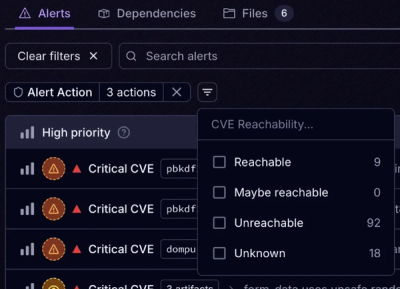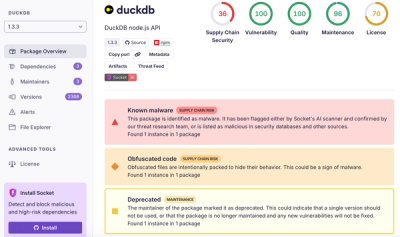
Product
Introducing Tier 1 Reachability: Precision CVE Triage for Enterprise Teams
Socket’s new Tier 1 Reachability filters out up to 80% of irrelevant CVEs, so security teams can focus on the vulnerabilities that matter.
.. image:: https://img.shields.io/travis/carsongee/flask-htpasswd.svg :target: https://travis-ci.org/carsongee/flask-htpasswd .. image:: https://img.shields.io/coveralls/carsongee/flask-htpasswd.svg :target: https://coveralls.io/r/carsongee/flask-htpasswd .. image:: https://img.shields.io/github/issues/carsongee/flask-htpasswd.svg :target: https://github.com/carsongee/flask-htpasswd/issues .. image:: https://img.shields.io/pypi/dm/flask-htpasswd.svg :target: https://pypi.python.org/pypi/flask-htpasswd/ .. image:: https://img.shields.io/pypi/v/flask-htpasswd.svg :target: https://pypi.python.org/pypi/flask-htpasswd/ .. image:: https://img.shields.io/badge/license-BSD-blue.svg :target: https://github.com/carsongee/flask-htpasswd/blob/master/LICENSE
Flask extension for providing basic digest and token authentication
via apache htpasswd files. So largely it fits between Flask-Security <https://pythonhosted.org/Flask-Security/>_ which has additional
dependencies and Flask-BasicAuth <http://flask-basicauth.readthedocs.org/en/latest/>_ which only
allows you to have one user (and also puts the plain text password
into the configuration).
Sample usage is to first create an htpasswd file with the apache tool <http://httpd.apache.org/docs/2.2/programs/htpasswd.html>_:
.. code-block:: bash
htpasswd -c /path/to/.htpasswd my_username
Additional users can be added, or have their passwords changed, by running:
.. code-block:: bash
htpasswd /path/to/.htpasswd new_user htpasswd /path/to/.htpasswd user_I_want_to_change_passwords_for
Then you just need to setup and configure your flask application, with something like:
.. code-block:: python
import flask from flask_htpasswd import HtPasswdAuth
app = flask.Flask(name) app.config['FLASK_HTPASSWD_PATH'] = '/path/to/.htpasswd' app.config['FLASK_SECRET'] = 'Hey Hey Kids, secure me!'
htpasswd = HtPasswdAuth(app)
@app.route('/') @htpasswd.required def index(user): return 'Hello {user}'.format(user=user)
app.run(debug=True)
And that view should now prompt for a username and password (and accept tokens).
If you would like to protect all of your views, that is easy too, just
add a little config. By setting app.config['FLASK_AUTH_ALL']=True
before initializing the extension, an @app.before_request is added
that will require auth for all pages, and it will add the user as
flask.g.user.
One last small feature, is that you can also set the authentication
realm. The default is 'Login Required', but it can be set with
app.config['FLASK_AUTH_REALM'] before initialization.
Tokens are based on the username and password, and thus invalid whenever the user's password is changed. To get a user password, you can serve it out to the user with something like
.. code-block:: python
import flask from flask_htpasswd import HtPasswdAuth
app = flask.Flask(name) app.config['FLASK_HTPASSWD_PATH'] = '/path/to/.htpasswd' app.config['FLASK_SECRET'] = 'Hey Hey Kids, secure me!' htpasswd = HtPasswdAuth(app)
@app.route('/') @htpasswd.required def index(user): return flask.jsonify({'token': htpasswd.generate_token(user)})
app.run(debug=True)
It can then be used by the user by adding it to the header of their requests, something like:
.. code-block:: python
import requests
requests.get('http://localhost:5000/', headers={'Authorization': 'token '})
0.5.0
- Switch from itsdangerous to pyjwt
- Renamed FLASK_SECRET into FLASK_SECRET
0.4.0
0.3.0
- Added function to reload user database
- Added user to ``flask.g`` with FLASK_AUTH_ALL=True
0.2.0
This is largely based on a combination of:
https://flask.pocoo.org/snippets/8/ <https://web.archive.org/web/20190706125230/https://flask.pocoo.org/snippets/8/>_Links
* `documentation
<https://github.com/carsongee/flask-htpasswd/blob/master/README.rst>`_
* `development version
<https://github.com/carsongee/flask-htpasswd/archive/master.tar.gz#egg=flask-htpasswd-dev>`_
FAQs
Basic authentication support via htpasswd files in flask applications
We found that flask-htpasswd demonstrated a healthy version release cadence and project activity because the last version was released less than a year ago. It has 1 open source maintainer collaborating on the project.
Did you know?

Socket for GitHub automatically highlights issues in each pull request and monitors the health of all your open source dependencies. Discover the contents of your packages and block harmful activity before you install or update your dependencies.

Product
Socket’s new Tier 1 Reachability filters out up to 80% of irrelevant CVEs, so security teams can focus on the vulnerabilities that matter.

Research
/Security News
Ongoing npm supply chain attack spreads to DuckDB: multiple packages compromised with the same wallet-drainer malware.

Security News
The MCP Steering Committee has launched the official MCP Registry in preview, a central hub for discovering and publishing MCP servers.